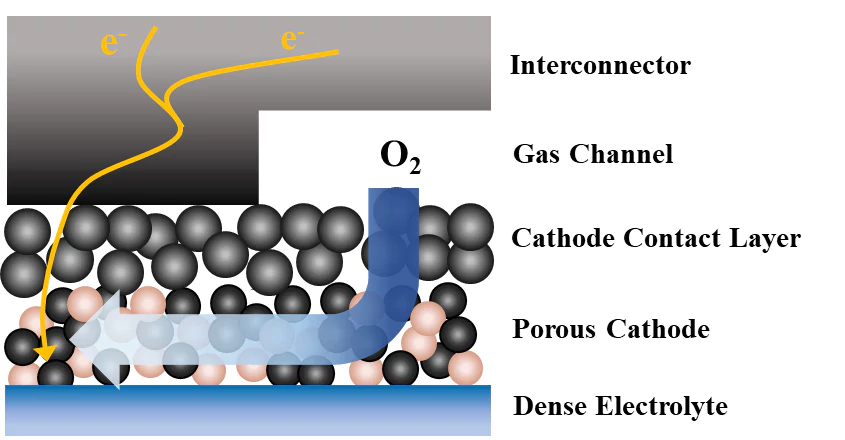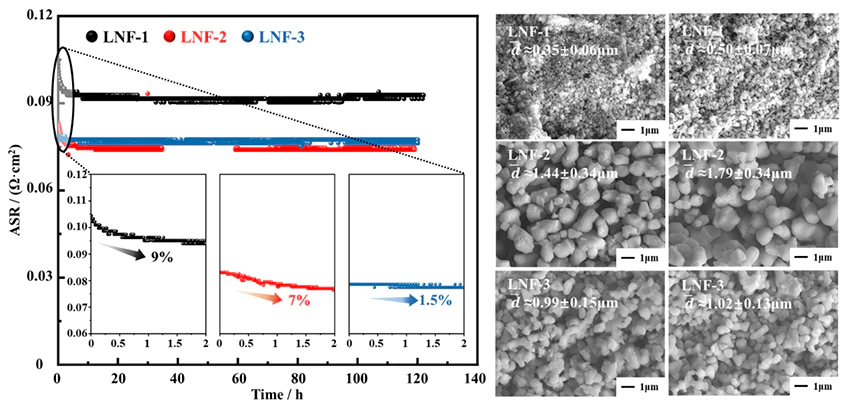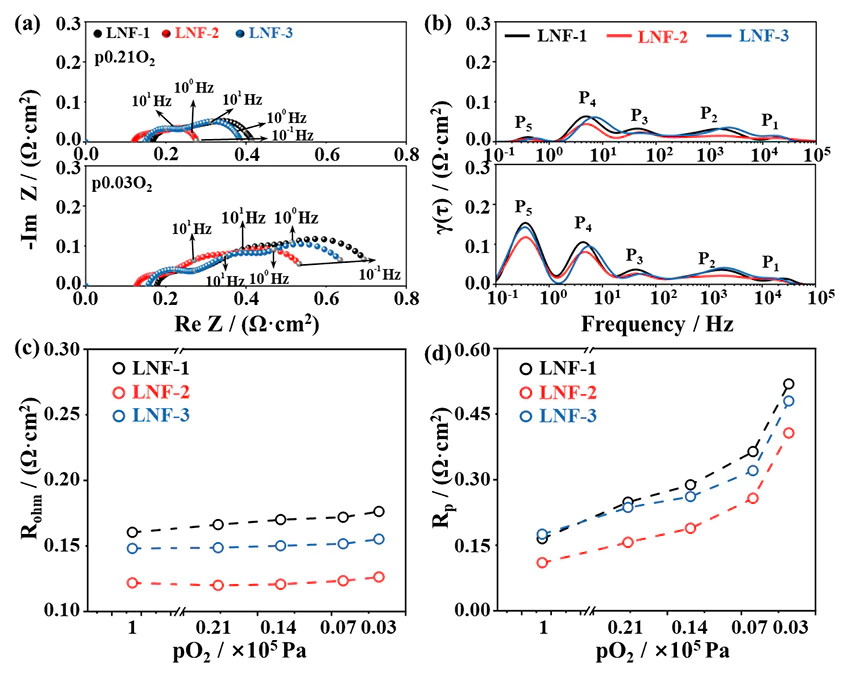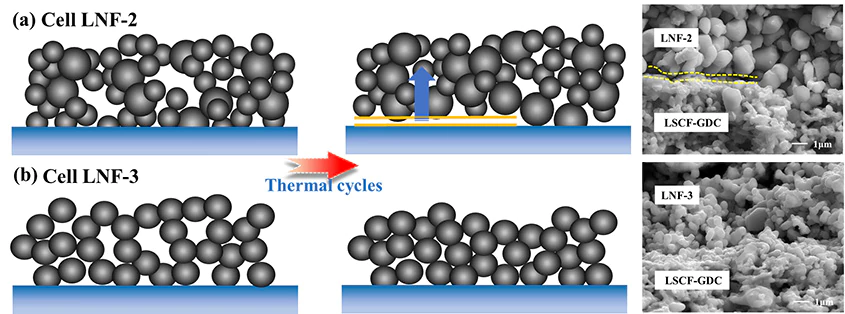LaNi0.6Fe0.4O3 Cathode Contact Material: Electrical Conducting Properties Manipulation and Its Effect on SOFC Electrochemical Performance
ZHANG Kun, WANG Yu, ZHU Tenglong, SUN Kaihua, HAN Minfang, ZHONG Qin. LaNi0.6Fe0.4O3 Cathode Contact Material: Electrical Conducting Properties Manipulation and Its Effect on SOFC Electrochemical Performance[J]. Journal of Inorganic Materials, DOI: 10.15541/jim20230353.

Schematic diagram of the cathode and interconnector contact interface
During the assembly process of the flat solid oxide fuel cell (SOFC) stack, the direct contact between the ceramic cathode and the metal connector is poor and the stress is high. It is easy to produce large interface contact resistance, which in turn affects the performance and stability of the stack. A cathode contact layer is usually added between the cathode and the connector to improve the interface contact. LaNi0.6Fe0.4O3 (LNF) has the advantages of high electrical conductivity and matching thermal expansion coefficient with cathode and connector materials. It is a widely used contact layer material in flat-plate SOFC. However, during the long-term operation of the stack, LNF has phenomena such as particle coarsening and significant changes in surface resistance, which leads to damage to the contact interface and thus affects stack performance. Zhu Tenglong's research group at Nanjing University of Science and Technology used two methods, dry pressing granulation and high-temperature sintering, to prepare large particle LNF materials, and studied the evolution of surface resistance under current load and its impact on the electrochemical performance of SOFC single cells.

ASR evolution of LNF versus time under 750 ℃ and 1A/cm2, SEM images of LNF before and after ASR test(a) Initial; (b) Post-test
Research indicates. Compared with untreated LNF-1, LNF-2 and LNF-3 that have undergone dry pressing granulation and high-temperature sintering have lower initial surface resistance. The particle size of small particle size LNF will increase significantly under current load. Although the LNF-2 granulated by dry pressing has a larger particle size, it retains better sintering activity, so it also shows a more obvious sintering phenomenon under current load, resulting in a reduction in sheet resistance. LNF-3 that has undergone high-temperature sintering pretreatment has basically lost its sintering activity, and its particle size changes little under the action of current, so its surface resistance remains stable. In addition, the ohmic impedance of LNF-2 and LNF-3 single cells with larger particle sizes is smaller than that of LNF-1, which is related to their lower contact component area resistance and better cathode interface contact. At the same time, both LNF-2 and LNF-3 single cells showed smaller polarization resistance, indicating that increasing the LNF particle size can improve the transmission and diffusion of oxygen in the air on the cathode side. In multiple thermal cycle experiments, the LNF-2 single cell showed excellent initial electrochemical performance, but still retained good sintering activity due to its own. During long-term operation at high temperatures and multiple electrochemical performance tests, its particles are more likely to coarsen, causing pore damage and interface peeling, leading to significant attenuation of single cell performance. In contrast, LNF-3 materials that have undergone high-temperature sintering pretreatment have poor sintering activity and can maintain good structural stability during high-temperature thermal cycles.

EIS spectra (a) and DRT fitting plots (b) of single cells under oxygen partial pressure of 2.1×104 and 3×103 Pa, and their corresponding Ohmic resistance (c) and polarization resistance(d)
Highlights of this article:
1. Compared with untreated LNF-1 material, particle-controlled LNF-2 and LNF-3 can reduce sheet resistance. The surface resistance of the contact component can quickly reach a steady state under current load, and the structure can be maintained stable under long-term current load conditions.
2. Large particle size LNF contact material can optimize cathode interface contact, promote oxygen diffusion and transport on the cathode side, and improve single cell output performance.
3. The dry-pressed granulated LNF material still retains a certain sintering activity, resulting in poor thermal cycle stability. High-temperature sintering pretreatment can significantly improve the structural stability of LNF cathode contact materials during thermal cycling and discharge processes.

Schematic diagrams and SEM images for cathode contact interfaces of single cells after thermal cycling
Comment:
1. In this article, the author studies the evolution of the surface resistance of the cathode contact assembly due to the particle size of the LNF material and its impact on the electrochemical performance and stability of the SOFC single cell. It was found that increasing the particle size through high-temperature sintering reduces the sheet resistance of the cathode contact assembly. The surface resistance of the contact component can quickly reach a steady state under current load and the structure can be maintained stable under long-term current load conditions, which provides a good reference for improving the performance of SOFC.
2. This research is oriented to the actual needs of low resistance and high conductivity contact materials for solid oxide fuel cell stacks. The mechanism of the influence of LaNi0.6Fe0.4O3 particle size control on conductivity and SOFC single cell performance was studied, and the influence of operating conditions such as air oxygen content and thermal cycle on single cell performance during LNF granulation using different means was analyzed in detail. The concept of the paper is relatively novel, the thinking is clear, the data listed can well support the corresponding issues, and has certain practical application value. The article has a clear structure, reasonable logic, and standardized writing.